The QuickBooks the file you specified cannot be opened error is a common error that can arise while updating the payroll service, paying taxes, or opening state or federal forms. It can get triggered when the file you want to access is not found in the system or is already used by another user. To learn how to fix this error, follow this comprehensive blog till the end.
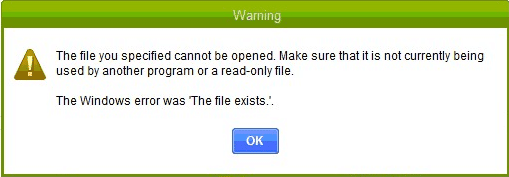
The inability to open the specified file in QuickBooks can prevent users from completing payroll updates and using payroll features, like paying taxes. Thus, this error needs to be addressed as soon as possible. If you need professional guidance to resolve this error effectively, you can reach out to our team of QB experts by dialing +1 833-802-0002.
Reasons Why The File You Specified Cannot Be Opened in QuickBooks Desktop
There can be many reasons why you are unable to open the specified file in QB. It is essential to learn about these reasons before troubleshooting the error for better clarity. This QuickBooks payroll error can occur due to the following common causes –
- You are not running QuickBooks without admin rights, which can cause issues while updating payroll.
- The current QuickBooks Desktop version might be outdated, leading to compatibility problems while downloading payroll updates.
- There are internet connection issues, or the internet security settings might be misconfigured.
- The Windows firewall or an anti-virus program might create blockages and interferences while running payroll updates.
- Your QB Desktop program might be damaged, corrupted, or improperly installed on the PC.
- The Windows User Account Control settings are enabled, which can interfere with the update process.
These are some of the major causes behind the “the file you specified cannot be opened” message in QB. Now, let’s proceed to the next section to learn how to resolve this error effectively.
Solutions to Resolve the File You Specified Cannot be Opened in QuickBooks Error
Since this payroll error can hamper the payroll update process, it needs to be resolved immediately. Thus, once you have gone through the reasons behind this error, you can follow the troubleshooting solutions given below –
Solution 1 – Run QB Desktop with Admin Rights
Lack of admin privileges can cause the “the file you specified cannot be opened error in QuickBooks Desktop.” Thus, run the application with admin rights in the following manner –
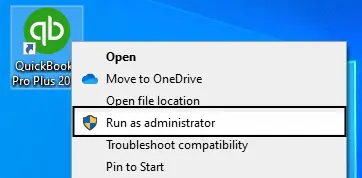
- Open the Windows Start menu, type “QuickBooks” into the Windows search bar, and right-click the QB Desktop version you want to open.
- Now, select Run as Administrator to run QB with admin rights.
Once you’ve done this, download the latest payroll updates and close QuickBooks. If you cannot update payroll, pay taxes, or open forms because you cannot open the specified file, move to the next solution.
Solution 2 – Install the Most Recent QBDT Updates
Your QuickBooks version needs to be up-to-date; otherwise, you might face this payroll error. Thus, make sure that QBDT is updated to the latest release by implementing the following steps –
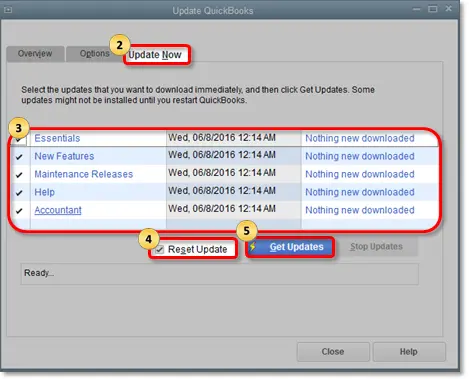
- Launch QB, go to the Help menu, select Update QuickBooks Desktop, and click Update Now.
- Mark the Reset Update checkbox, select Get Updates, and once the updates are downloaded, restart QB.
- Lastly, click Install Now to install the downloaded QB updates.
After updating QuickBooks, rerun the payroll updates to check if the error has been eliminated. If you still face the “the file you specified cannot be opened QB” message while updating payroll, paying taxes, or opening forms, proceed to the next solution.
Solution 3 – Update Windows Permissions and Provide Full Control
You need to provide proper permissions to access any file in QuickBooks. To update the Windows permissions, follow the detailed steps mentioned below –
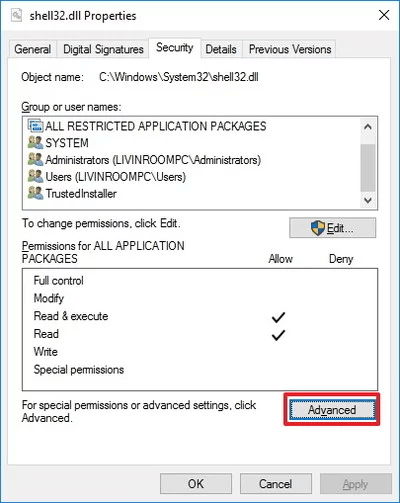
- First, go to the Windows Start menu, search for “Windows File Explorer,” and open the program.
- Next, find your QuickBooks program file, right-click (QBW32.EXE) file, and click Properties.
- Select Security, hit Edit, and click Add, then go to the next window.
- In the window, type “Everyone” and click OK, then go to the Security window.
- Further, select the checkbox for Full control, select OK, then click Add again.
- In the window, type “Users,” then select OK, and move to the Security window.
- Select the checkbox for Full control, hit OK, and when you’re ready, select Apply and click OK to close the settings.
After the Windows permissions are set, run QuickBooks and download the payroll updates. However, if you are still getting the error while updating or running payroll, follow the next troubleshooting solution.
Solution 4 – Run a QB Desktop Repair
A damaged QB program or installation issues can be responsible for the “QB file you specified cannot be opened” error. To fix this, you need to repair QuickBooks Desktop by using the QuickBooks Tool Hub utility in the following manner –
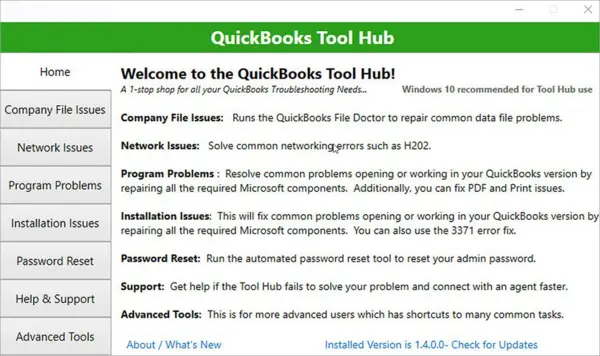
The first step is to download and install QuickBooks Tool Hub so that you can run the relevant tools to get rid of the ongoing issue.
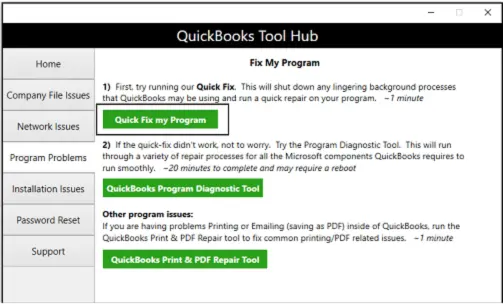
Secondly, open QB Tool Hub and run the Quick Fix My Program tool. If the issue still persists despite running the Quick Fix My Program tool, scroll down to run the QuickBooks Install Diagnostic tool.
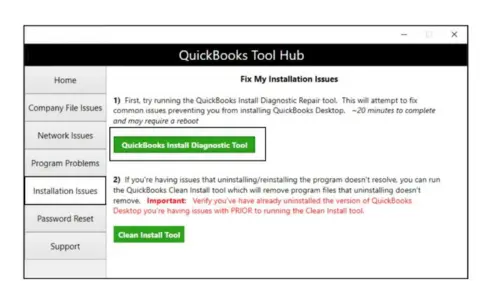
Lastly, if nothing works, run the QuickBooks Install Diagnostic Tool.
Next, ensure that QuickBooks is updated to the latest release, and try to update payroll again. If you still encounter the QuickBooks error “the file you specified cannot be opened,” move to the next solution.
Solution 5 – Clean Install QB Desktop
If repairing QuickBooks Desktop doesn’t fix the payroll error, you can try reinstalling it. Clean installing QuickBooks can help get rid of the installation problems by installing a fresh version of the app. To run the clean installation, go through the following steps –
Step 1: Uninstall/Remove QuickBooks
You need to remove the current QuickBooks Desktop version from your device before installing a new version. Make sure to back up your company files and note down the product and license information of the current QuickBooks version beforehand. Then follow the steps given below to remove the QB software from the system –
- First, open the Windows Start menu, search for “Control Panel,” and open it.
- Next, select the Programs and Features or Uninstall a program option, and choose QuickBooks from the list of installed apps.
- Lastly, click the Uninstall/Change, Remove option, and hit Next. If you can’t find the “Uninstall/Change or Remove” option, sign back into Windows with admin rights, then proceed to remove QuickBooks.
Once the QB software is removed, move to step 2 below and rename the installation folders.
Step 2 – Modify the Name of QB Installation Folders
The next step is to rename the QB installation folders to prevent QuickBooks from using them during the reinstallation. Implement the following detailed steps to change the installation folder name –
- Search for “Windows File Explorer” in the Windows search panel, select it, and go to the company file folder. The company file folder is usually the QuickBooks Folder that can be found in one of the following locations –
- C:\ProgramData\Intuit\QuickBooks (year)
- C:\Users\(current user)\AppData\Local\Intuit\QuickBooks (year)
- C:\Program Files\Intuit\QuickBooks (year)
- 64-bit version C:\Program Files (x86)\Intuit\QuickBooks (year)
- Next, right-click the folder, select Rename, add “.old” at the end of the folder name, and press Enter.
However, if you get an access error message while renaming the installation folder, end the QuickBooks processes using the following steps –
- Right-click the Windows Task Bar, click Task Manager, then navigate to the Processes menu.
- Further, select the Name column header and sort the list, then select the QB processes, namely QBDBMgrN.exe, QBDBMgr.exe, QBCFMonitorService.exe, and Qbw32.exe, one at a time.
- Lastly, select End Process for each .exe process, and when the “WARNING: Terminating a process can cause undesired results…” message appears, click Yes.
After renaming the QB installation folder, reinstall QuickBooks Desktop in the next section.
Step 3: Reinstall QuickBooks Desktop
Before installing QuickBooks Desktop, ensure that your system meets the minimum system requirements and that the license and registration numbers are readily available to activate QuickBooks. Then, perform the steps provided below to reinstall and activate QBDT –
- Go to the (CAMPs) or the download site to download the QB setup file, then save the .exe setup file to an easily accessible location on the computer.
- Next, open the QuickBooks.exe file downloaded above, follow the on-screen instructions to install, and accept the license agreement.
- Now, hit Next, enter your product and license numbers, and click Next again.
- Ensure you have an active internet connection, then proceed further and select the installation type.
- Select Express Install as the Installation Type, hit Next, and click the Install option.
- Once the installation finishes, reopen QB, move to the Help section, and select Activate QuickBooks Desktop.
- Lastly, follow the on-screen instructions to verify your info, and enter the Product and License Info to complete the activation process.
After you have successfully reinstalled QuickBooks Desktop, run the payroll updates again. If you are still getting the QuickBooks “the file you specific cannot be opened” error message, move to the next solution.
Solution 6 – Run QuickBooks Reboot.bat File as an Admin
The reboot.bat file is a batch file in the QuickBooks program files folder that registers the .DLL and .OCX files. Running the reboot.bat file with admin rights by following the steps below can help fix the payroll error –
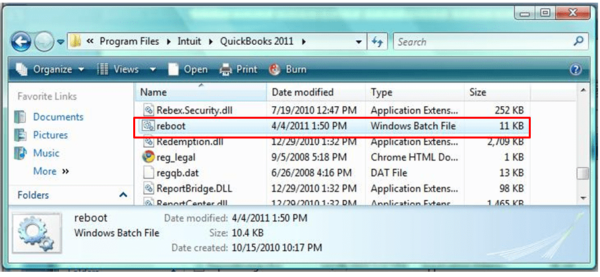
- Firstly, close QB, then right-click the QuickBooks Desktop icon and select Properties.
- Next, select the Open file location option, look for the Reboot.bat file, and right-click the file name, then choose Run as Admin.
- Now, let the Reboot.bat file re-register all crucial QuickBooks files, and once done, reboot Windows.
Once done, rerun QuickBooks and update the payroll service to check if the QuickBooks “the file you specified cannot be opened in Windows 10” issue is resolved. However, if you are still facing the issue, go to the next solution and disable UAC.
Solution 7 – Disable User Account Control Settings
The User Account Control improves security for users and minimizes the exposure to threats to protect your operating system. However, sometimes, disabling the UAC settings might be necessary to troubleshoot QuickBooks issues. You can turn the UAC off in the following manner –
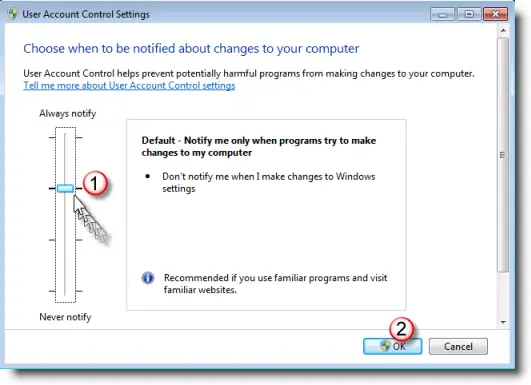
- Press the Windows + R keys to access the Run window, then type Control Panel, and click OK.
- Next, select User Accounts, click User Accounts (Classic View), and select the Change user account control settings option. If UAC prompts, select Yes to proceed further.
- Lastly, move the slider, set it to Never Notify, and then select OK to turn UAC off.
Note: Afterward, make sure to enable UAC to prevent security risks on your PC.
Once done, relaunch QuickBooks and download the latest payroll updates. If you are still facing the QB payroll error, follow the next troubleshooting solution.
Solution 8 – Fix Windows Firewall and Anti-Virus Configuration
Misconfigured Windows firewall settings might create blockages while running QuickBooks. These restrictions prevent the application from accessing the internet, causing payroll update errors, like the “the file you specified cannot be opened” error in Quickbooks Desktop. To fix this error, reconfigure the firewall and anti-virus program by implementing the steps given below –
Step 1 – Use the QuickBooks File Doctor Utility
The QuickBooks File Doctor tool is an essential utility of the QB Tool Hub that can fix company file and network problems. QB File Doctor can configure the Windows firewall automatically. Before running this tool, install the latest QB Tool Hub version (see ‘Step 1: Download and Install QB Tool Hub’ of ‘Solution 4: Run a QB Desktop Repair’ above), then go through the following steps –
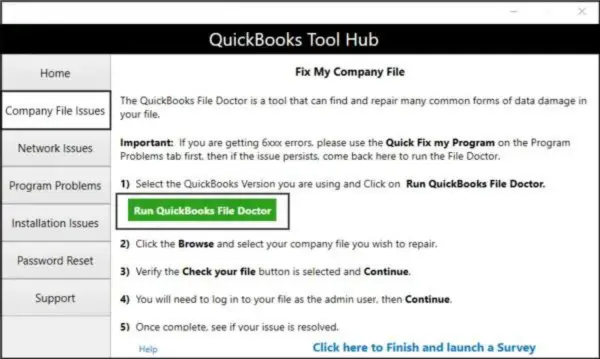
- Launch the QB Tool Hub program, navigate to the Company File Issues section, and select the QuickBooks File Doctor tool.
Note: QB File Doctor might take up to a minute to open, but if it isn’t accessible, search for “QuickBooks Desktop File Doc” in the Windows search panel and manually open it. - After the tool opens, choose the company file you want to repair from the drop-down list. If you can’t find the company file, select Browse and Search, find and select the file, and proceed with the repair.
- Further, click Check your file and network, select Continue, then enter your QB admin credentials.
- Hit Next and wait for the company file scan process to end, then launch QuickBooks and open the company file.
Note: The tool usually takes up to 5 minutes to scan the company file. Also, the time taken by the tool depends on the size of the company file. Sometimes, the scan may say the process was unsuccessful, even if the company file and network problems are addressed.
Once done, check if you can download the payroll updates and use its features, like paying taxes. However, if the payroll error persists, move to step 2 and manually configure the Windows firewall settings.
Step 2 – Configure Windows Firewall Settings Manually
If the network and firewall issues aren’t fixed, you need to manually configure the Windows firewall settings. To configure the firewall, create exceptions for QuickBooks Desktop in the following manner –
Create Firewall Exception Rules for QuickBooks Ports
To create exception rules and allow QuickBooks ports to bypass the firewall restrictions, follow the steps given below –
Note: You need to configure the Windows firewall for each QBDT version you are using on the same PC. In case of multiple versions, add each QBDT year’s ports in the Specific Local Ports field in Step 4 below.
- Firstly, open the Windows Start menu, type “Windows Firewall” in the Windows search bar, and select it in the search results.
- Further, go to the Advanced Settings section, right-click Inbound Rules, and click New Rule.
- Now, select Port and hit Next, then checkmark the TCP option if it has not already been selected.
- Enter the specific ports (as per your QB Desktop version) in the Specific Local Ports field by using the following list –
- QuickBooks Desktop 2020 and later: 8019, XXXXX.
- QuickBooks Desktop 2019: 8019, XXXXX.
- QuickBooks Desktop 2018: 8019, 56728, 55378-55382.
- QuickBooks Desktop 2017: 8019, 56727, 55373-55377.
Important: QBDT 2019 and later versions use dynamic ports specifically assigned to QuickBooks while installing the software. Dynamic ports provide QuickBooks Desktop exclusive use of a particular port. If you use any of these QBDT versions, add their dynamic port number to the port exception list.
- To know the Dynamic Port Number for your QBDT version (year), follow these steps –
- Enter “QuickBooks Database Server Manager” in the Windows search panel, launch it, and go to the Port Monitor tab.
- Next, find your QuickBooks Desktop version, note the Port Number, and add it to the port exceptions list.
Note: If you use QBDT 2019 or future versions, the assigned port can be edited by clicking Renew. If you want to renew the port number, click Scan Now from the Scan Folders menu, then set the Windows firewall permissions again.
- After adding the port number to the exceptions list, click Next and select Allow the Connection.
- Click Next, and once all the profiles are checkmarked (if asked), hit Next again.
- Now, create a new rule named “QBPorts(year),” click Finish, and then create Outbound Rules.
- Lastly, create Outbound Rules for QB ports by following steps 1 to 8 above, but choose Outbound Rules instead of Inbound Rules in Step 2.
Once the firewall exception rules for QuickBooks ports are created, check if you can update QB payroll without any error. However, if the “the file you specified cannot be opened” QB error persists, create exceptions for QB .exe files in the next step.
Create Firewall Exception Rules for QB Executable Files
The executable files in QuickBooks are used to undertake various functions and tasks. You can create firewall exceptions for these executable (.exe) files by using the following steps –
- In the Windows search bar, type “Windows Firewall,” then open it and go to the Advanced Settings tab.
- Next, right-click Inbound Rules, select New Rule, and click the Program option.
- Hit Next, select This Program Path, then click Browse and choose a .exe file from the table below –
| Executable files | Location |
| AutoBackupExe.exe | C:\Program Files\Intuit\QUICKBOOKS YEAR |
| Dbmlsync.exe | C:\Program Files\Intuit\QUICKBOOKS YEAR |
| DBManagerExe.exe | C:\Program Files\Intuit\QUICKBOOKS YEAR |
| FileManagement.exe | C:\Program Files\Intuit\QUICKBOOKS YEAR |
| FileMovementExe.exe | C:\Program Files\Intuit\QUICKBOOKS YEAR |
| QuickBooksMessaging.exe | C:\Program Files\Intuit\QUICKBOOKS YEAR |
| QBW32.exe | C:\Program Files\Intuit\QUICKBOOKS YEAR |
| QBDBMgrN.exe | C:\Program Files\Intuit\QUICKBOOKS YEAR |
| QBServerUtilityMgr.exe | C:\Program Files\Common Files\Intuit\QuickBooks |
| QBCFMonitorService.exe | C:\Program Files\Common Files\Intuit\QuickBooks |
| QBLaunch.exe | C:\Program Files\Common Files\Intuit\QuickBooks |
| QBUpdate.exe | C:\Program Files\Common Files\Intuit\QuickBooks\QBUpdate |
| IntuitSyncManager.exe | C:\Program Files\Common Files\Intuit\Sync |
| OnlineBackup.exe | C:\Program Files\QuickBooks Online Backup |
- Further, hit Next, click Allow the Connection, then select Next again and ensure all the profiles are marked (if prompted).
- Select Next, then save the file exception rule as “QBFirewallException(name.exe),” and proceed to create Outbound Rules.
- Now, follow steps 1 to 5 above to create Outbound Rules for the executable files, but choose Outbound Rules instead of Inbound Rules in step 2.
Once the inbound and outbound rules are created for the executable files, relaunch QB and download the payroll updates. Check if you are still getting the “the file you specified cannot be opened” error message in QBDT. If yes, then move to step 3 and configure the antivirus software.
Step 3 – Review the Antivirus Software Settings
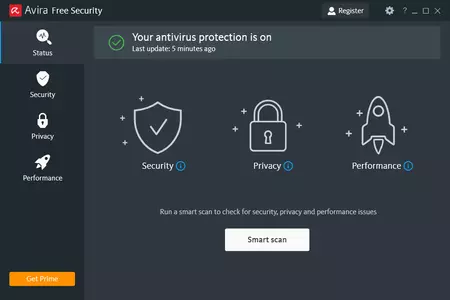
If manually configuring the Windows firewall doesn’t help, configure the antivirus program settings. By configuring the settings, you can ensure that QB has proper permissions and is running without restrictions from the antivirus software. To review the settings, undertake the specific steps for your particular antivirus program. You can visit the official website of your current antivirus program or contact your vendor to learn how to configure it properly.
After the anti-virus program is configured to restrictions on QuickBooks are removed, rerun the payroll update process. Then, check if you can pay taxes and open the forms to ensure the error is fixed.
Conclusion
The solutions provided in this detailed guide will help you fix the QuickBooks “the file you specified cannot be opened” error. However, if these solutions aren’t effective and you are still facing the payroll error, you can get direct assistance from our team of QB professionals by dialing +1 833-802-0002.
FAQs
Can the QuickBooks “the file you specified cannot be opened” error arise if the file is located on a network drive?
Yes, this error can occur if the network drive that contains the specified file is inaccessible. In such a case, you can move the file to the local storage of the system and try to access it again.
Can the “the file you specified cannot be opened” error message in QB arise due to a damaged company file?
Yes, a damaged company file might be responsible for this error while updating payroll, paying taxes, or opening forms. If you suspect data damage in the company file, use QuickBooks File Doctor and run the Verify/Rebuild Data tool. Additionally, the error can be fixed by restoring the file backup.
How can you fix the “the file you specified cannot be opened” QuickBooks error while opening or printing forms?
This QB payroll error while opening the state or federal form can occur if the printer is damaged. To fix this, remove the QBPrint.qbp file in the following manner –
Press the Windows + R keys, open the Run window, access the Control Panel, and select the Devices and Printers option.
Next, right-click on the Device, select Remove, and remove the printer that is facing issues.
Now, open the Task Manager (use the shortcut key Ctrl + Alt + Del), locate the QBW32.exe process and right-click it.
End the QBW32.exe process, click Yes, then navigate to the C drive.
Further, choose Program Data, then select Intuit, and click QuickBooks.
Lastly, find and delete the file named QBPRINT.qbp, reboot the system and relaunch QB.

James Richard is a skilled technical writer with 16 years of experience at QuickBooks Data Migration. His expertise covers data migration, conversion, and desktop errors for QuickBooks. He excels at explaining complex technical topics clearly and simply for readers. Through engaging, informative blog posts, James makes even the most challenging QuickBooks issues feel manageable. With his passion for writing and deep knowledge, he is a trusted resource for anyone seeking clarity on accounting software problems.
